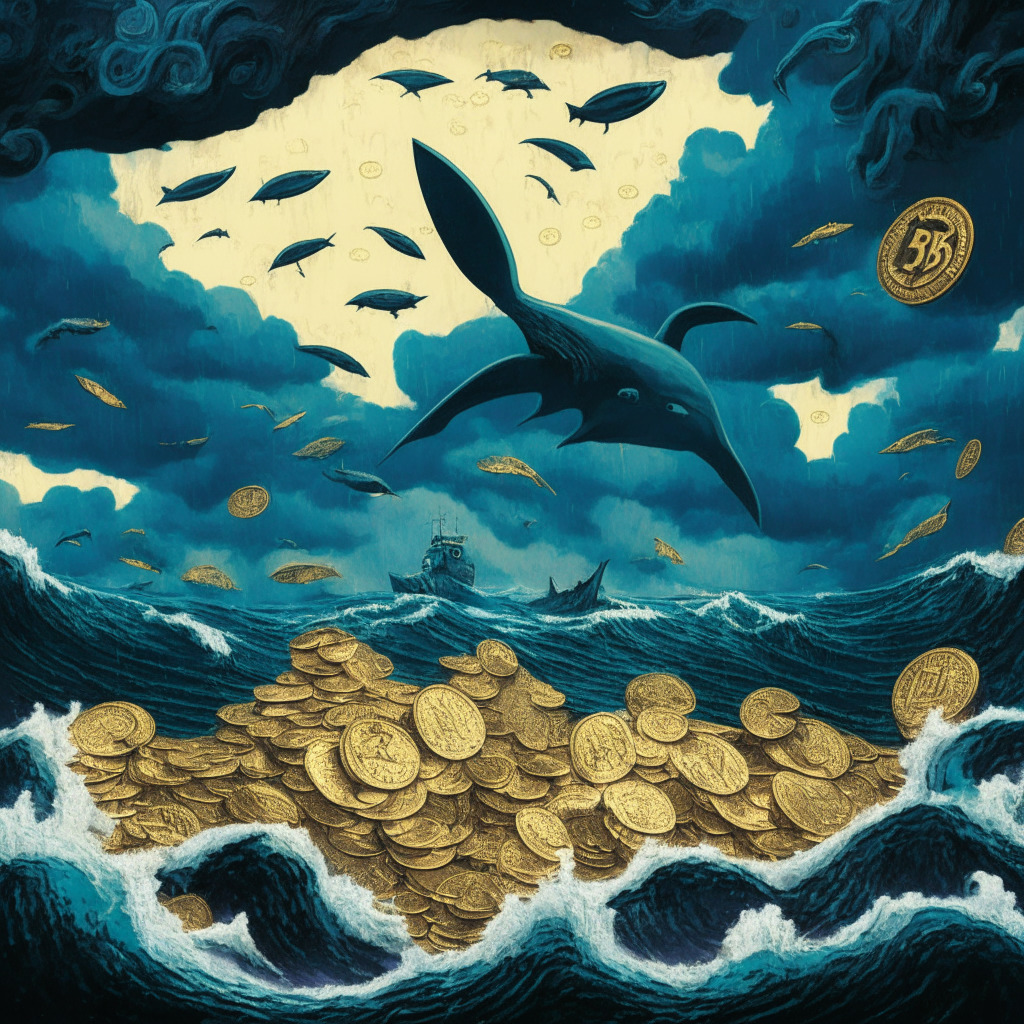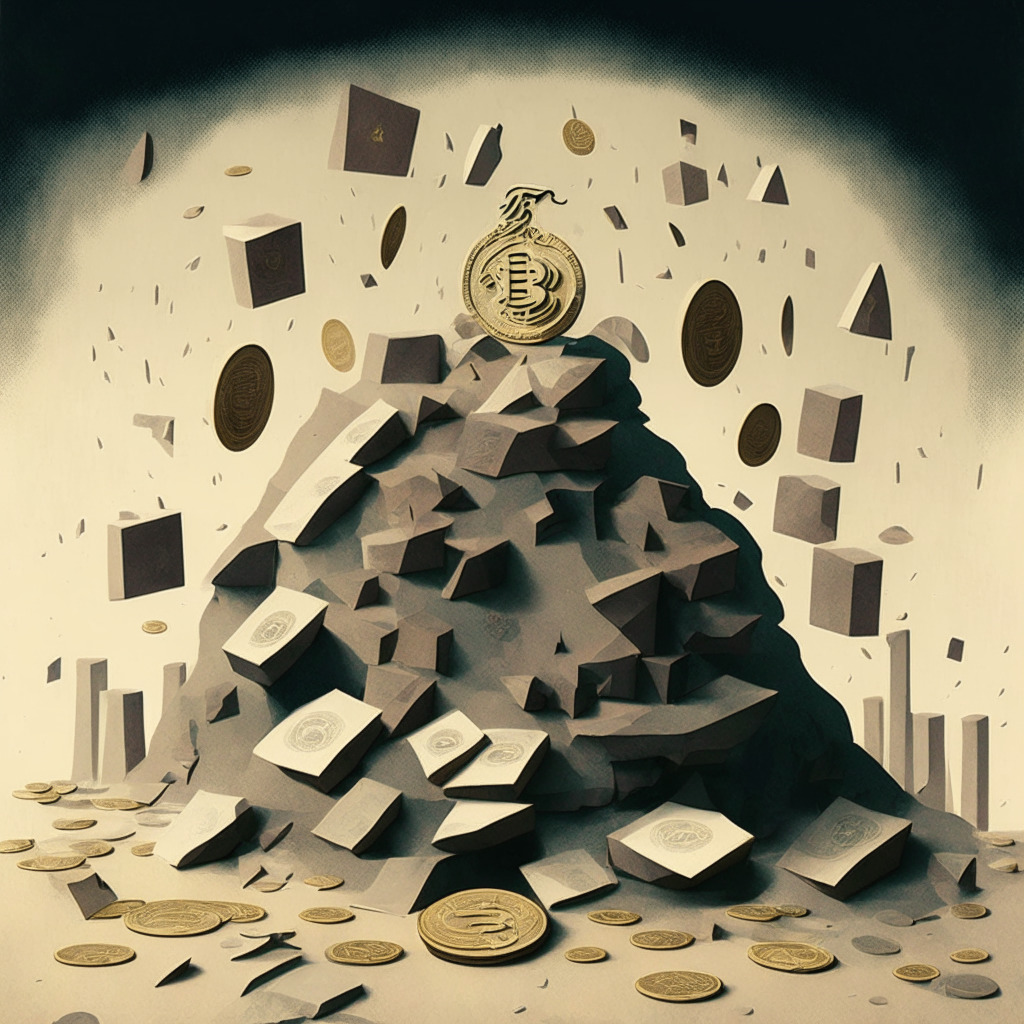“In the world of digital assets, the role and impact of stablecoins is increasingly complex. Despite declining holdings in exchanges and concerns about their potential financial instability, Tether-based stablecoin loans have increased in 2023. The place of stablecoins in crypto markets presents an intricate web of contradictions and uncertainties.”
Search Results for: usdt
Rollercoaster Ride into Blockchain: Ether Futures ETFs, High-Profile Arrests, and Uncertain Regulations
“Deep shifts in the blockchain realm bring unprecedented changes to its future. Ether futures ETFs are being launched by firms such as Valkyrie and VanEck. However, the looming U.S. government shutdown may disrupt this progress. Meanwhile, the arrest of 3AC’s co-founder Su Zhu, the fraud charges against FTX’s former CEO, and uncertainty among Binance users add to the complex dynamics shaping the blockchain future.”
Merging Worlds: AI Revolution Hit Crypto Trading with Cogwise’s $COGW Token Launch
“Cogwise, the new player in the crypto landscape, merges cryptocurrency and AI to offer innovative trading tools. With its $COGW token, Cogwise positions itself as a rival to OpenAI, offering services like conversation AI model, Real-Time Trading and Smart Alerts.”
Expanding Horizons: Ledn’s Ethereum Yield Product & Coinbase’s Regulatory Campaign
Ledn is introducing an Ethereum yield product in response to user demand for simpler staking alternatives. Their new offering is “ring-fenced,” providing a safety layer against bankruptcy. Ledn is also launching a stablecoin Growth Account, though not available in the U.S. or Canada. Meanwhile, Coinbase is seeking clearer crypto regulations, despite skepticism due to political and regulatory concerns.
Navigating Complex Debt: Founder of DeFi Protocol Curve’s Multi-Million Dollar Maneuver
Michael Egorov, founder of DeFi protocol Curve, employed a strategy to settle his extensive obligations on Aave. He deposited millions of CRV as collateral on a lending platform, and borrowed Curve’s crvUSD stablecoin, which he exchanged for USDT to clear his Aave debt. Despite significant outstanding debt across several DeFi platforms, Egorov has been proactive in lessening his debt and usage rate.
Crypto Collision: As Binance Hits Regulation Wall, Is a New Era Dawning for Cryptocurrencies?
“The decentralised nature of cryptocurrencies is colliding with regulatory restrictions, as evidenced by Binance’s recent challenges. Big payment providers like Paysafe are halting operations, reflecting the global shift in the crypto industry towards greater regulatory scrutiny. However, it remains unclear whether this increased regulation will help or hinder the market’s organic growth.”
Binance vs. Paysafe: The Euro Conversion Crunch and Its Implications for Crypto Users
Binance, facing debanking difficulties, has urged its European users to convert Euros to Tether (USDT) due to unilateral action by banking partner, Paysafe. The latter halted processing EUR deposits for Binance users, requiring the alternative stablecoin transformation to maintain liquidity while seeking new banking solutions. This reflects the strategic challenges crypto exchanges face amidst tightening regulatory landscapes.
Hong Kong’s Controversial Stance on Crypto: Safety Measures or Hindrance to Mass Adoption?
“Hong Kong-based crypto exchange Hashkey HK has started trading Avalanche (AVAX) but with a specific condition – only professional investors with a portfolio exceeding $1 million can trade AVAX. Hashkey HK mandates users deposit $1,500 for KYC verification.”
Navigating Stormy Waters: How Curve Finance Founder’s Debt Reduction Casts Light on DeFi’s Potential Pitfalls and Promises
“Michael Egorov, founder of Curve Finance, reduced his debt to $42.7M through repayment on Aave’s DeFi platform and other key protocols. Despite the near $100M debt risk and a $47M loss from a security vulnerability that caused a CRV token price crash, Egorov continued to decrease his debt, offering a cautionary tale on DeFi debt and blockchain security risks.”
Unraveling Stablecoins: Booming Assets or Impending Crisis?
“This report by the United States Federal Reserve Banks reveals the potential impact of stablecoins on the economy. Highlighting the similarity between stablecoins and money market funds, it warns of the vulnerabilities these coins face during market downturns. Issues like risky backing collateral and erosion of investor confidence can lead to substantial losses.”
Expanding the Stablecoin Universe: Circle’s EURC Now on Stellar Network
Stablecoin issuer Circle has introduced a new version of its euro-backed stablecoin, EURC, now available on the Stellar network. This innovation offers users the ability to handle business via blockchain networks in local currencies. However, converting blockchain transactions into local currencies remains complicated, highlighting the integration challenges that the blockchain community faces.
Federal Reserve Concerns: Stablecoins’ Instability or the Next Financial Evolution?
“Federal Reserve Banks express concern that stablecoins could introduce instability into the financial system due to lack of standard regulatory framework. The Central Bank of Italy reinforces stablecoins’ unstability and presses for international regulatory body to govern cryptocurrencies. Despite risks, blockchain-based cross-border payments show promise of cost-effective solutions.”
Navigating Cryptocurrency Volatility Amid Dollar Strength and Market Security Concerns
“The cryptocurrency market currently indicates US dollar index dominance with Bitcoin (BTC) and Ethereum (ETH) experiencing a downward trend. Contributing risk factors seem to arise from the enduring US dollar strength and uncertain global economic health. However, signs of a bullish divergence suggest possible reduction in selling pressure. Meanwhile, controversy surrounds the Mixin Network due to a significant security breach, highlighting concerns about fund security in cryptocurrencies.”
Arbitrum’s Swift DAO Maneuver: A Power Leap or a Fall into Uncertainty?
The Arbitrum Foundation recently transferred unclaimed tokens worth $56 million into their network’s decentralized autonomous organization (DAO) treasury. While offering new governance possibilities, this move also carries risks and obligations for token holders, speaks volumes about the future for Arbitrum’s users, and poses questions about the speed of tokenizing and redistributing actions within just six months of their DAO launch.
Exploring Tether’s Surprise ToS Shift: Unseen Implications for Singapore-Based Users and Crypto Futures
“Tether, the largest stablecoin issuer, has made a significant shift in its terms of service (ToS), restricting access for certain Singapore-based clients, causing anxiety among the crypto-user base. This may be a strategic adherence to regulatory compliance after a major Singaporean crypto scandal or a rebuttal against potential restrictions jeopardizing their operations.”
Crypto Week Review: Binance vs SEC, Tether Lifeline for Tron and Controversy at FTX
This article explores recent developments in the crypto world, including the SEC’s setback in their investigation into Binance.US, the proposed dismissal of a lawsuit against Binance and its CEO, and delay in repayments by defunct exchange Mt. Gox. Noteworthy is Tether’s decision to authorize $1 billion USDT to the Tron network, a lawsuit against FTX founder’s parents, and Grayscale filing for a new Ether futures ETF.
Declining Dominance of Stablecoins: A Shift Towards Traditional Assets or a Chance for Recovery?
Despite a difficult year, the focus stays on the declining stablecoin sector, with major stablecoins like USDT showing consistent growth amidst the downturn. Factors such as legal action against major crypto exchanges and swings in stablecoin trading volumes due to the rush to list Bitcoin ETFs have impacted this fall. However, PayPal’s recent introduction of PYUSD could revive confidence in the sector. The future of stablecoins, while currently unstable, is still pivotal to the crypto landscape.
The Dwindling Dominance of Stablecoins: A Market Shift Towards Traditional Assets
Stablecoin market dominance has declined to 11.6%, despite a 10.9% rise in trading volume for such currencies. Despite challenges faced by cryptocurrencies, the launch of PayPal’s stablecoin PYUSD might revive investor faith in stablecoins, and encourage broader crypto adoption.
Tether’s Loan Strategy: Growth by Risk or Recipe for Disaster?
Tether, the company behind the popular USDT stablecoin, reportedly lends out stablecoins at a high level, with loans amounting to $5.5 billion as of end-June 2021. However, concerns arise given the lack of clear transparency about the firm’s liquidity, capital reserves, and loan specifics. Reassurance comes from Tether’s claim that its tokens are fully supported by cash or liquid assets.
Dwindling Stablecoin Dominance: A Strategic Investor Shift or a Market Trend?
“Stablecoins have experienced a 17-month decline, losing market dominance by 11.6%, with a total sector drop of $124 billion. Despite this, stablecoin trading volume has grown by 10.9%. Some propose investors are cashing out stablecoins to diversify into traditional assets due to rising yields in fixed-income securities and cryptocurrencies. This pivot raises questions about the future behavior of the crypto market.”
Crypto World Featuring: The JPEX Scandal, Mt. Gox Delays, and DCS’ New Venture
Last week’s Token2049 conference saw Hong Kong cryptocurrency exchange JPEX staff flee amid arrest threats over a $166M scandal. The incident, which potentially affected 2,000 users, emphasized the need for trading platform awareness and regulatory measures to ensure safe trading.
Tether’s Undisclosed Investment in Northern Data: A Blockchain Breakthrough or Transparency Crisis?
Tether has made an undisclosed investment in German-based crypto miner, Northern Data Group, potentially involving AI, P2P communications, and data storage solutions. Despite past controversies and questions around its financial management and transparency, this move could signify a turning point for Tether and have significant implications for the blockchain industry.
TG.Casino’s Game-Changing Token Pre-Sale: Future of Crypto Gambling and Where Investors Stand
TG.Casino, a leading Telegram-based casino, has launched a pre-sale for its tokens, $TGC, amassing $140,000 within minutes. The casino stands out with anonymous and instant Web3 deposits, robust security, and no-KYC access. TG.Casino aims to generate $5 million from its token supply, using profits to maintain price stability and boost potential growth.
HK’s JPEX Scandal: A Wake-Up Call for Crypto Regulation and the Struggle for Innovation Balance
In a recent scandal, Hong Kong’s JPEX crypto exchange faces investigation by the Securities and Futures Commission and police for exaggerated licensing claims. The incident highlights the necessity for regulatory oversight, proper licencing, and transparent operations in the crypto industry.
Resilience in Cryptocurrency: The Curious Case of Rising Stablecoin Loans by Tether Despite Planned Elimination
“In an intriguing move, Tether has seen a rise in stablecoin loans despite an earlier announcement to eliminate these. The reason being short-term loan requests from long-standing clients. Transparency issues have arisen, however, Tether defends the over-collateralization of these loans while gaining market dominance and profit. This venture provides lessons on cryptographic money lending.”
PayPal’s Venmo and the Stalled Adoption of PYUSD Stablecoin: Analysis and Future Implications
“PayPal’s mobile payment platform, Venmo, has begun offering its Ethereum-based stablecoin, PYUSD, marking a significant step toward integrating cryptocurrency with mainstream finance. Despite its robust structure and support, PYUSD’s adoption has been slow, likely due to competition and regulatory contradictions.”
PayPal’s Entry into Stablecoin Could Disrupt Financial Markets: Quigley’s Forecast & Scrutiny
Tether co-founder William Quigley has noted that PayPal’s venture into stablecoin could revolutionize multicurrency transactions by reducing costs. However, whether PayPal will transfer these savings to end users or retain them as profit is yet to be seen.
Billionaire Mark Cuban’s Cryptocurrency Heist: A hard Lesson on Crypto Safety
Billionaire investor Mark Cuban recently lost nearly $900,000 in crypto from his hot wallet in a swift heist. The security breach highlights the inherent risks of dealing with cryptocurrencies, stressing the need for robust anti-money laundering, fraud detection, and regulatory measures. Even seasoned investors like Cuban are reminded to maintain vigilance and ensure precautions when interacting with these digital assets.
Ripple’s Liquidity Hub Expansion: Impact on XRP Demand and Diversification Into BTCBSC
“Ripple Labs plans to extend its Liquidity Hub platform to Australia and Brazil. The Hub serves as Ripple’s digital asset liquidity management service, currently supporting BTC, ETH, LTC, ETC, BCH, USDT and USDC, but not XRP. This hints at wider XRP adoption globally and is seen as a positive indicator, despite ongoing litigation with the SEC.”
Cryptocurrency Heist: A Wake-Up Call on the Need for Elevated Security Measures in the Blockchain Landscape
A suspicious withdrawal of around $2.7 million worth of cryptocurrencies from Remitano crypto exchange brought to light potential security breaches. The immediate response included Tether halting the movement of drained coins, saving a significant portion of the stolen funds. However, the security issue emphasizes the importance of vigilant security measures in the crypto landscape.
Breach in Remitano: Navigating the Tightrope between Blockchain’s Security and Decentralization
“Cryptocurrency exchange Remitano fell victim to a hack, with $2.7 million withdrawn suspiciously. This incident raises questions over blockchain’s security. The unauthorized withdrawal included Tether, USD Coin, and Ankr tokens. Despite Tether freezing the suspected address, concerns persist about potential misuse of centralized control against crypto’s decentralization principle.”
Exploring the Boom of Telegram Bot Tokens: Opportunities, Risks, and The Role of TON Space
“A recent revelation by crypto security firm, Certik, suggests that over 40% of Telegram Bot tokens may be exit scams. The rise in such tokens, some with dubious utility, was triggered by initial successes like UNIBOT. However, at the same time, Telegram announced their new self-custodial wallet, TON Space, introducing another variable in the evolving landscape of blockchain.”































